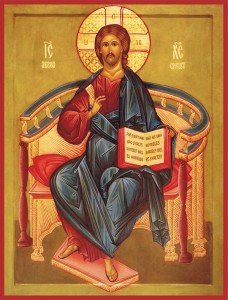 In the last issue I began sharing the thoughts of the Fathers on Christ’s Humanity and our ability to depict Him in iconography. Christ is the image of the Father. Therefore, if we image Christ we, in effect, also image the Father since Christ is the human image of the Father. However, since Christ’s personal identity is that of the Son of God, an image of Christ is an image of God, who makes himself visible as man. “In former times,” wrote John of Damascus, “God, who is without form or body, could never be depicted. But now [i.e., after the incarnation] when God is seen in the flesh conversing with men, I make an image of the God whom I see. I do not worship matter; I worship the Creator of matter, who became matter for my sake, who willed to take His abode in matter; who, through matter, worked out my salvation.”
In the last issue I began sharing the thoughts of the Fathers on Christ’s Humanity and our ability to depict Him in iconography. Christ is the image of the Father. Therefore, if we image Christ we, in effect, also image the Father since Christ is the human image of the Father. However, since Christ’s personal identity is that of the Son of God, an image of Christ is an image of God, who makes himself visible as man. “In former times,” wrote John of Damascus, “God, who is without form or body, could never be depicted. But now [i.e., after the incarnation] when God is seen in the flesh conversing with men, I make an image of the God whom I see. I do not worship matter; I worship the Creator of matter, who became matter for my sake, who willed to take His abode in matter; who, through matter, worked out my salvation.”
As you might realize, many Christians cannot accept this fact. They still maintain that God is not someone who can be imaged. Yet, when you think about it, if we truly believe that Jesus is God incarnate and that, since God is One, although Three-In-One, then the incarnate God is imaged in the Person of Jesus.
Thus, an icon of Christ became a complete Christological confession of faith, presented visually – a mystery of salvation and communion that words can express only partially. In the Byzantine tradition, the intention of the artist was to represent the personal identity of the incarned God (hence the Greek letter in the nimbus, ho on, “the One-Who-Is”, the Septuagint version of YHWH, the name of God), but always under the historical traits of Jesus of Nazareth. So, to use the words of a sermon of John of Damascus on the Feast of the Transfiguration, “the things human become those of God, and the divine those of man, by the mode of mutual communication, and the interpenetration without confusion of the one into the other, and of the truly extreme union according to the hypostasis [or person]. For He is one God – He who is eternally God, and who later became man.”
If you study the true writings of the Fathers, it makes all kinds of sense. If Jesus is truly God and man and that which joins the two is really His personhood, then He becomes the true image of God in human form and the image of Jesus that we create through icons, is the image of God. Many, as you can imagine, cannot accept this truth.
